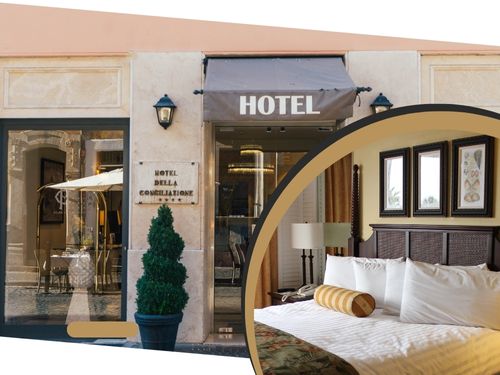
Micro-Luxury Hotels Redefining Travel with Intimate Style

In a world where travel is increasingly about personalization and authenticity, a new trend has emerged that redefines the concept of luxury. Micro-luxury hotels, often small in size but grand in experience, are capturing the hearts of travelers seeking something more intimate, curated, and memorable. Unlike sprawling resorts or chain hotels, these tiny properties focus on delivering exceptional attention to detail, bespoke services, and unique experiences that larger hotels struggle to offer.
Micro-luxury is more than just a size distinction. It is a philosophy of travel that emphasizes quality over quantity. These hotels might have just a handful of rooms or even a single suite, but every aspect of the stay is designed to feel personal and exclusive. From locally sourced décor to customized dining experiences, micro-luxury hotels create a sense of place and authenticity that makes each visit unforgettable. They cater to travelers who want more than a bed and breakfast. They are designed for those who seek stories, emotions, and connections along with comfort.
The Appeal of Micro-Luxury
Why are travelers turning to micro-luxury stays? One key reason is personalization. When a hotel has a limited number of guests at a time, the staff can provide service that is finely tuned to individual preferences. Imagine arriving at a boutique hotel where the receptionist remembers your name, your favorite drink is waiting for you, and your room is arranged precisely to your liking. This is the essence of micro-luxury. Guests are not just numbers. They are individuals whose preferences matter and whose experiences are crafted with intention.
Another factor driving this trend is the desire for privacy and intimacy. In traditional luxury resorts, crowds and noise can sometimes overshadow the experience. Micro-luxury hotels often offer secluded locations, from quiet city streets to hidden coastal spots. These settings enable guests to relax, unwind, and fully immerse themselves in the environment, free from the distractions of mass tourism. For solo travelers, couples, or small groups, this intimacy is invaluable.
Exceptional Design in Tiny Spaces
One of the most striking features of micro-luxury hotels is their design. Despite limited square footage, these spaces feel open, airy, and luxurious. Architects and designers often employ clever space-saving techniques and thoughtful aesthetics to maximize comfort and visual appeal. For example, built-in furniture, multi-purpose rooms, and minimalist design elements ensure that every inch of space serves a purpose.
Micro-luxury hotels also excel in storytelling through design. Many properties incorporate local materials, artwork, and cultural elements into their décor, creating a strong sense of place. A tiny boutique hotel in Kyoto might feature handcrafted wooden screens, tatami mats, and traditional ceramics. At the same time, a micro-luxury stay on the Amalfi Coast might feature vibrant local tiles and open-air terraces with stunning views of the sea. In each case, the design not only enhances comfort but also immerses guests in the surrounding culture and landscape.
Curated Culinary Experiences
Dining is a cornerstone of the micro-luxury experience. Small hotels often offer personalized menus, locally sourced ingredients, and unique culinary experiences that larger hotels cannot replicate. A chef might prepare a tasting menu tailored to your dietary preferences, or offer cooking classes that teach regional recipes using ingredients from nearby farms. In some cases, hotels collaborate with local artisans and producers, ensuring that meals are not just food but a cultural experience.
For example, at a micro-luxury hotel in Tuscany, guests might enjoy a private wine tasting in a vineyard, paired with farm-to-table dishes crafted by the resident chef. In Bali, small hotels often offer sunrise breakfasts featuring freshly caught fish and tropical fruits, served in an open pavilion overlooking the rice terraces. These culinary touches transform a simple meal into a lasting and unforgettable memory.
Wellness and Experiential Focus
Micro-luxury hotels place a strong emphasis on wellness, treating it as an integral part of the guest experience rather than an add-on. These properties often feature bespoke spa treatments designed to soothe both body and mind, personalized yoga sessions that cater to different skill levels, and guided meditation practices that help guests reconnect with themselves. Some even offer curated nature-based wellness activities, such as forest bathing, sunrise hikes, or mindful coastal walks, giving travelers a chance to reset in serene, intimate settings. Unlike sprawling resorts where wellness offerings can feel generic or overcrowded, micro-luxury stays tailor programs to each guest’s preferences, ensuring a deeply restorative and individualized experience.
Experiential travel is equally central to the micro-luxury ethos. These hotels go beyond the conventional tourist route, offering thoughtfully curated activities that immerse guests in the local culture and community. Guests may join a private culinary class with a renowned local chef, explore hidden historical sites with expert guides, or attend intimate performances and cultural events that are typically inaccessible to the general public. Artisanal workshops, such as pottery, weaving, or cocktail crafting, enable visitors to take home tangible skills and personal creations. This focus on experience transforms travel from mere sightseeing into a collection of memorable, meaningful moments, fostering genuine connections with people, places, and traditions.
Notable Examples Around the World
The global micro-luxury landscape is as varied as it is inspiring, offering travelers bespoke experiences tailored to their interests and preferences. In Europe, Positano on Italy’s Amalfi Coast is a standout destination. Small cliffside hotels here provide breathtaking panoramic views of the Mediterranean, private terraces perfect for sunset cocktails, and intimate pools that feel like your own slice of paradise. Guests often enjoy personalized concierge services that help them explore hidden coastal paths, secluded beaches, and local artisan shops, making each stay uniquely memorable.

In Asia, Kyoto’s boutique ryokans showcase the elegance of traditional Japanese hospitality. These tiny hotels often feature tatami-matted rooms, shoji-screened interiors, and private onsen baths where guests can soak in mineral-rich waters while enjoying serene views of the garden. Seasonal Kaiseki meals, crafted with meticulous attention to detail, highlight the region’s freshest ingredients, turning dining into a deeply cultural experience. Across the Americas, historic mansions in cities like Charleston and San Miguel de Allende have been transformed into intimate hotels, combining colonial charm with modern luxuries. Guests here can wander through beautifully preserved architecture, enjoy personalized tours, or participate in local culinary and art experiences that bring the destination’s heritage to life.
Australia offers a different kind of micro-luxury Block Stylingadventure. Eco-retreats in Tasmania and Queensland emphasize immersion in nature without sacrificing comfort. Guests might spot rare wildlife, take guided forest walks, or unwind in stylish, sustainably designed accommodations that blend seamlessly into their natural surroundings. Despite their differences in style and setting, all these properties share a unifying philosophy: delivering high-quality, fully immersive experiences within compact, thoughtfully curated spaces that prioritize personal attention, authenticity, and connection.
Technology Enhancing the Stay
While these hotels often emphasize tradition and craftsmanship, they do not overlook technology. Many micro-luxury hotels use smart room controls, high-speed Wi-Fi, and app-based concierge services to enhance convenience without compromising the personal touch. Guests can easily adjust the lighting, temperature, and entertainment systems, while still enjoying the intimate service that defines micro-luxury.
Digital tools also allow hotels to anticipate guest needs. Reservation systems can store preferences, while personalized recommendations for local experiences help travelers maximize their stay. The integration of technology ensures comfort and efficiency while preserving the boutique, high-touch feel of the property.
Sustainability and Ethical Practices
Sustainability is another pillar of micro-luxury. Smaller hotels can adopt eco-friendly practices more effectively than large chains, from energy-efficient systems to locally sourced materials. Many properties focus on minimizing waste, using renewable energy, and supporting local communities. This allows travelers to enjoy luxury responsibly, knowing their stay aligns with their values.
For instance, some micro-luxury lodges in Costa Rica run on solar power, compost food waste, and partner with local artisans to create décor and amenities. Guests participate in conservation efforts, including guided tours that educate them about local ecosystems. This approach adds depth to the experience and connects travelers with the destination in meaningful ways.
Tailoring Luxury for the Modern Traveler
Micro-luxury is especially appealing to modern travelers who prioritize experiences over possessions. Millennials and Gen Z travelers, in particular, are drawn to boutique stays that provide a sense of authenticity and uniqueness. These guests often seek Instagram-worthy moments, but they also value sustainability, wellness, and meaningful interactions with local culture.
Micro-luxury properties cater to this desire for balance, offering small-scale luxury with a strong sense of purpose. Unlike generic five-star hotels, each stay is distinctive, reflecting the property’s and its staff’s personalities. Travelers feel seen, valued, and immersed in an environment that feels curated just for them.
Making the Most of a Micro-Luxury Stay
To truly enjoy a micro-luxury stay, travelers should approach it with mindfulness and curiosity. Here are a few tips:
- Engage with the staff: Ask questions about the hotel’s history, the local culture, or the chef’s favorite dishes. Small hotels thrive on personal interaction.
- Embrace local experiences: Participate in workshops, tours, or wellness activities offered by the hotel. These add depth to your stay.
- Travel light: Smaller rooms mean less storage, so packing efficiently enhances your comfort and mobility.
- Disconnect to reconnect: Many micro-luxury properties encourage digital detox. Take this opportunity to focus on yourself and your surroundings.
As travelers increasingly value quality over quantity, micro-luxury is poised to experience significant growth. The industry may see more niche offerings, such as small urban hotels in the heart of metropolitan areas, remote eco-lodges, and ultra-specialized properties that cater to wellness, gastronomy, or adventure enthusiasts. With their focus on personalization, sustainability, and experience, these tiny hotels offer oversized memories that remain with guests long after checkout.
Micro-luxury is redefining what it means to stay in style. It is proof that size does not determine the richness of an experience. Whether perched on a cliff, hidden in a forest, or tucked into a bustling city street, tiny hotels are providing travelers with the kind of thoughtful, curated stays that leave a lasting impression. These hotels invite us to slow down, savor every detail, and discover the extraordinary in a space that may be small in size but vast in imagination, comfort, and connection.